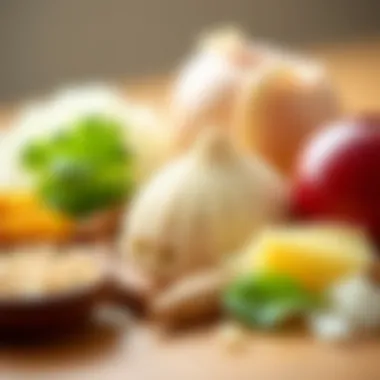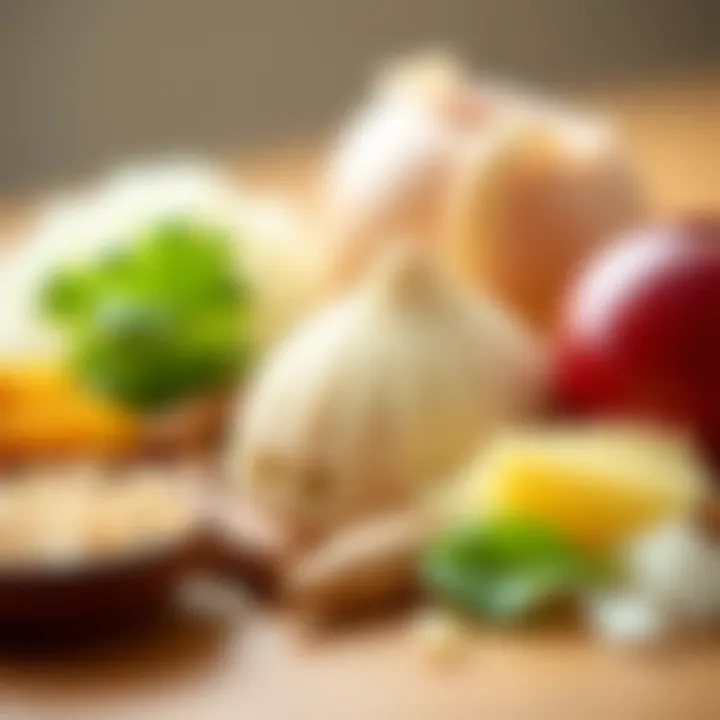The Cultural Significance and Flavor Profile of Mariano's Cake


Intro
Mariano's cake, a marvel on any dessert table, is much more than just a sweet treat; it is a canvas reflecting the rich tapestry of cultural history and culinary creativity. This cake, with its unique flavors, has captured the hearts and palates of many, inviting enthusiasts to explore its roots, variations, and evolving interpretations. In this exploration, we will traverse the journey of Mariano's cake, from its origins to its modern-day adaptations, while dissecting the key characteristics that make each bite a memorable experience.
Recipe Overview
Recipe Name
Mariano's Cake
Description of the Dish
At its core, Mariano's cake is a layered confection that marries textures and flavors, offering a delightful surprise in every forkful. With a base often rich in moist sponge, this cake is typically complemented by creamy frostings, fresh fruits, or even nuts, depending on regional preferences. Each layer tells a story; each bite evokes memories of family gatherings, celebrations, or simply, a quiet afternoon with tea. Its aesthetic appeal lies not just in its taste but also in the artistry of its presentation, often adorned with seasonal fruits or delicate chocolate shards.
Ingredients
List of Ingredients with Measurements
- 2 cups all-purpose flour
- 1 ½ cups granulated sugar
- ½ cup unsalted butter, softened
- 1 cup buttermilk
- 3 large eggs
- 1 teaspoon vanilla extract
- ½ teaspoon baking powder
- 1 teaspoon baking soda
- ½ teaspoon salt
- For frosting: 2 cups heavy cream, whipped; 1 cup powdered sugar; 1 teaspoon vanilla extract
- Fresh fruits for decoration (strawberries, blueberries, or seasonal fruits of choice)
Special Notes on Ingredients
- Substitutions: If buttermilk is unavailable, a mix of milk and vinegar can work as a substitute. Simply add one tablespoon of vinegar to a measuring cup, then fill it with milk up to the one-cup line, stirring well before use.
- Regional Variants: In certain parts of the world, local spices or oils may be added to enhance the flavor profile. For instance, a hint of almond extract or even citrus zest can elevate the cake's taste, adding a signature twist that reflects the area's unique culinary landscape.
"Cooking is about paying attention to what you are trying to do." - James Beard
This famous quote encapsulates the essence of preparing Mariano's cake. Every stir, every layer, every embellishment is steeped in intention and tradition. Whether one sticks to the classic recipe or experiments with variations, the goal remains the same: to create a cake that speaks volumes with its rich, layered history yet embraces the spirit of modern culinary exploration.
As we continue our journey, we will further dissect the nuances of Mariano's cake, exploring its historical significance in specific cultures, the twisting paths of its ingredient sourcing, and innovative methods for bringing this beloved dessert to life in your own kitchen. For more on the intermingling of tradition and innovation in baking, explore resources like Britannica.com or Wikipedia for a deeper understanding.
Preamble to Mariano's Cake
Mariano's Cake is more than just a dessert; it encapsulates culinary traditions, stories, and a unique blend of flavors that resonate with people from various backgrounds. This cake is not merely a recipe but a symbol of celebration and community. Understanding its importance involves recognizing how it bridges generations, cultures, and personal experiences. The journey of Mariano's Cake brings together elements of artistry in the kitchen and the emotional ties that accompany family gatherings and festive occasions.
Definition and Cultural Significance
Mariano's Cake can be defined as a rich, layered confection that often incorporates a variety of ingredients, each chosen for their unique flavors and textures. While the cake itself may vary from one region to another, its core essence remains: a comforting centerpiece for gatherings. The cultural significance of Mariano's Cake transcends its taste; it is often present at birthdays, anniversaries, and holidays, acting as a unifying force that gathers families around the table.
In many cultures, the act of baking and sharing this cake goes beyond mere sustenance. It can represent heritage, with each family often having their special recipe passed down through generations. When one bakes Mariano's Cake, it's like holding onto a piece of ancestral history—mixing traditions with today's culinary innovations. The cake embodies the sentiment of warmth, belonging, and the joy of sharing, making it a beloved staple in many households.
Overview of its Popularity
The popularity of Mariano's Cake has soared, especially in recent years, as more people take an interest in both traditional baking and the nuances of flavor. Social media platforms like Instagram and Pinterest have played a massive role in showcasing not only the cake's luscious appearance but also the creativity that can be applied to its preparation. Home bakers frequently share their interpretations, sparking culinary trends that lead to various adaptations.
In addition, the cake is increasingly featured in culinary shows and competitions, enhancing its visibility among food enthusiasts. Brick-and-mortar bakeries and online storefronts have also tapped into the growing demand, offering artisanal takes on the classic cake.
It's clear that Mariano's Cake has made its mark. Whether it’s the delicate balance of flavors or the sense of nostalgia it evokes, this cake captivates food lovers of all ages, leaving them eager to explore its depths and share their own experiences.
"Mariano's Cake is more than just a slice; it’s a slice of life, rich in history and flavor."
By understanding both its definition and widespread appeal, we set the stage to explore its historical context, ingredients, and the myriad of ways it can be enjoyed. This journey delves deep into what makes Mariano's Cake a cherished part of various culinary landscapes, an exploration that promises to educate and inspire.
Historical Context
The historical context of Mariano's Cake is essential to appreciate its richness and complexity. Understanding where and how this cake originated provides insight into not only culinary traditions but also cultural evolution. Every bite of Mariano's Cake tells a story about the people and their customs, linking generations together through shared recipes and flavors.
Origins of Mariano's Cake
Mariano's Cake, renowned for its soft texture and rich flavors, traces its roots back to a specific region known for its baking heritage. It is said that this cake was first crafted in artisan bakeries around the early 20th century. The legend goes that Mariano, a baker with a keen eye for quality ingredients and a flair for creativity, decided to blend traditional recipes with more exotic spices and local produce. This was an experiment that did not go unnoticed, quickly gaining popularity at local festivals and gatherings.
Interestingly, its unique combination of flavors found a way into the hearts and palettes of wider communities. The cake often features key ingredients like vanilla, cinnamon, and even citrus zest, reflecting the agricultural diversity of the region it hails from. These elements didn't just pop from nowhere; they were products of the earth, elevated through generations of knowledge and experience in baking.
Evolution Over Time
As Mariano's Cake continued to make waves beyond its local boundaries, adaptations began to emerge. Various regions, influenced by local tastes and available ingredients, started putting their spin on the cake. This evolution is fascinating: in southern regions, for instance, one might find a hint of chocolate or even a layer of fruit-infused cream brought into the fold. Each variation tells a tale of terrain, culture, and creativity.


With the dawn of the digital age, Mariano's Cake encountered yet another shift—its presence on social media platforms has helped to evolve traditional recipes into more modern interpretations. Home bakers began to share their own takes, leading to an explosion of unique recipes and decorating techniques shared across various online communities. What was once a simple regional dessert morphed into a canvas for culinary artists looking to marry tradition with innovation.
The beauty of Mariano's Cake lies in its adaptability, a testament to the changing tides of culture and taste.
In today’s world, this cake not only serves as a dessert but also as a symbol of shared history and communal bonding. Each slice speaks to the past while inviting a taste of the future, where bakers continue to experiment and explore the boundaries of this beloved traditional treat.
Ingredients That Define Mariano's Cake
Understanding the ingredients that come together in Mariano's cake allows us to appreciate not only the flavor but also the cultural heritage they represent. Each component plays a vital role in crafting this delightful dessert, capturing the essence of tradition while simultaneously paving the way for modern creativity.
Base Ingredients
Base ingredients lay the groundwork for Mariano's cake; they're the unsung heroes that bring the whole concept to life. A classic recipe typically incorporates flour, sugar, eggs, and butter. These are not just random components; they form the foundation upon which the entire cake relies.
- Flour: The type of flour—whether all-purpose, cake, or even gluten-free—can affect the texture. It’s essential for achieving that crumbly yet moist structure. The right flour helps the cake hold its shape without being too dense.
- Sugar: This sweetener does more than just add sweetness. It's responsible for the cake's moistness and can influence the browning process. Brown sugar or even honey can provide depth and a more nuanced flavor profile.
- Eggs: Their function goes beyond binding; they bring richness and provide the beautiful rise when beaten properly. Egg yolks add that luxurious texture while the whites add fluffiness when whisked to perfection.
- Butter: The choice between salted and unsalted butter can significantly change the cake’s flavor. Unsalted butter is often preferred to allow for precise control over salt levels, enhancing the cake’s subtle flavors.
In essence, the harmony of these base ingredients can determine whether your cake stands as a classic representation of tradition or a personal twist of modern creativity.
Flavor Enhancers
Flavor enhancers amplify the foundational taste profile of Mariano's cake, bridging the gap between tradition and culinary innovation. They are the spark that elevates a good cake to something truly memorable. Various enhancers can be used, but the key is understanding how they interact with the base ingredients.
- Vanilla Extract: Often considered a staple, high-quality pure vanilla extract just adds a warmth to the cake. It creates something almost nostalgic, a familiar embrace in every bite.
- Citrus Zest: Using zest from lemons, oranges, or even limes can cut through the sweetness and add brightness. A little goes a long way since the oils in the zest deliver a burst of flavor without adding moisture.
- Almond Extract: This is a common addition that can introduce a whole new layer of complexity. It can be particularly prevalent in certain regional variations, providing a fragrant, slightly nutty undertone that lingers on the palate.
- Spices: Nutmeg, cinnamon, or cardamom can turn an everyday cake into something special. These spices don't just add flavor; they evoke memories and feelings tied to celebrations and gatherings.
When these flavors intermingle with the base, they create a symphony that defines Mariano's cake, making each bite a revelation.
Decorative Elements
The final touch on Mariano's cake is just as crucial as the ingredients that go into it. A well-decorated cake not only appeals to the eyes but also enhances the overall experience of eating it. Decorating elements can vary widely based on personal preferences, seasonal themes, or cultural significance.
- Frosting: Buttercream is often the go-to here, but cream cheese frosting might serve as a tangy counterpart, especially for cakes paired with fruit. The thickness can affect how it adheres and the overall flavor it delivers.
- Fresh Fruits: Topping with berries, bananas, or citrus slices not only adds vivid color but also gives a refreshing bite of natural sweetness.
- Chocolate Shavings or Drizzles: Chocolate is a classic pairing known for enhancing richness while adding visual appeal. Whether sprinkled on top or drizzled down the sides, chocolate elevates any cake.
- Edible Flowers: Popular among modern bakers, they introduce an elegant aesthetic. They need to be properly sourced and safe for consumption to ensure they enhance rather than detract from the cake’s integrity.
- To achieve the right consistency, keep an eye on the butter's temperature. Too cold makes for a hard mix; too warm just slips away ungraciously.
In the end, decorative elements serve more than just a visual purpose; they complete the experience of Mariano's cake and express the baker's personality and creativity.
Regional Variations of Mariano's Cake
The world of Mariano's Cake isn't just a singular experience; it's a tapestry woven from various threads of regional lore and culinary practice. When diving into the topic of regional variations, one recognizes how this cake evolves in flavor and style depending on its geographical context, opening the door to a richer appreciation of its cultural significance. Understanding these nuances helps food lovers see Mariano's Cake not merely as a dessert but as a reflection of the people and traditions that have shaped it.
Differences Across Cultures
Each culture brings its own flair to Mariano's Cake, often adapting fundamental components to resonate with local tastes or dietary preferences. For instance, in Latin American countries, a version might include tropical fruits like guava or coconut, while in European variants, you may find richer ingredients such as hazelnuts or luxurious chocolate. These adaptations serve two purposes: they maintain the spirit of the original cake, while also catering to the palates of the community.
- In Italy, you might discover Mariano's Cake suffused with espresso, reflecting the deep-seated café culture prevalent in the region.
- Conversely, in Japan, this cake might feature matcha and red bean paste, artfully intertwining local gastronomic traditions into the fabric of the dish.
Aside from flavor adaptations, the method of preparation can differ worth noting, too. Some cultures prefer a more layered structure akin to a trifle, while others might stick to a simpler, single-layer cake. This variety enables home bakers to experiment within the same fundamental structure while adding their own cultural touch.
Local Ingredients and Techniques
When making Mariano's Cake, local ingredients play a critical role in shaping its character. In the Caribbean, for instance, bakers often incorporate rum-soaked fruits into their recipe, reflecting the region's rich history of sugar cane. Meanwhile, in some parts of North America, a hint of maple syrup might lend an earthy sweetness that's both nostalgic and distinctly regional.
Techniques also vary significantly. Baking styles and methods can be influenced by available resources and traditional practices:
- Altitude: In some mountainous regions, altitude can affect baking techniques. Recipes might require adjustments in temperature or ingredient ratios to achieve the desired texture.
- Ovens: In Sicily, bakers might use wood-fired ovens that impart a unique smokiness. This kind of authentic method is a nod to age-old practices that remain vital today.
Thus, regional variations highlight the role of context in culinary arts. They display a shared love for Mariano's Cake, while simultaneously underscoring the individuality and innovation of each community. As you explore Mariano's Cake across different cultures, it’s a reminder that no two cakes—and no two bakers—are alike.
Techniques for Creating Mariano's Cake
Creating Mariano's Cake successfully requires a blend of science and art, making it a rewarding yet challenging endeavor. At the intersection of tradition and contemporary practices, the techniques used can significantly influence the outcome, flavor, and presentation of the cake. Understanding the fundamentals then elevates the baking experience, ensuring each bite carries the essence of the cake's rich heritage while also allowing for personal touches.
Baking Fundamentals
The foundation of any cake is its batter and here lies the crux of good baking techniques. First things first, ingredients need to be at room temperature. This helps in achieving better emulsification and ensures all components come together for a smooth batter.


When incorporating ingredients, it's wise to follow this order: dry ingredients first, then wet ingredients, and finally, add any flavor enhancers. Such a process minimizes the chances of developing a dense texture. Pay special attention to measuring accurately; using a scale can prevent the common miscalculations associated with volume measurements.
Furthermore, oven temperature plays a crucial role in cake stability. Preheating the oven ensures even rising of the cake; if the temperature is off, one might end up with an uneven structure. Ideally, cakes should bake until a toothpick inserted in the center comes out clean, but different types of Mariano’s cakes may require tweaking throughout the baking process.
Decorating Tips
The visual appeal of Mariano's Cake is as important as its flavor. When it comes to decoration, simplicity often speaks volumes. One can opt for simple frosting made from butter and sugar, but there’s nothing wrong with experimenting with ganache or cream cheese frostings for a richer experience. Here are some quick tips:
- Play with textures: Consider incorporating sprinkles or crushed nuts for a delightful crunch alongside the silky frosting.
- Natural elements: Fresh fruits or edible flowers can provide not just color but also a fresh contrast to the cake's richness.
- Layering: Creating a multi-layered cake is not only striking but allows for various flavors to shine through.
By utilizing a spatula or a piping bag, one can achieve elegant designs or even whimsical decorations that reflect personal preferences or special celebrations.
Common Mistakes to Avoid
When attempting to create a beautiful Mariano's Cake, certain pitfalls can hinder the final result. One major mistake is overmixing the batter, which can lead to a dense and tough texture. Remember, mixing should be just enough to combine the ingredients.
Another typical error is neglecting to check freshness of ingredients—especially baking powder. Ensure that your dry leavening agents are still 'alive'; a simple way to test baking powder is to mix a teaspoon with water to see if it bubbles.
Futhermore, skipping the cooling step before decorating can result in melted frosting and a ruined presentation. Letting the cake cool completely helps maintain the structure and flavor integrity.
Lastly, having a cake that’s not stored in an airtight container could ruin the moisture balance. Be sure to cover it properly or store it in a cake dome to keep it fresh longer.
In baking, each nuance matters. Elegance lies in the details.
By honing these essential techniques—from the basic baking fundamentals to aware decorating practices and avoiding common mistakes—bakers can create a Mariano's Cake that not only satisfies the palate but also honors its rich lineage in every slice.
Modern Interpretations of Mariano's Cake
The journey through Mariano's cake is not just one of raw tradition; it’s also a canvas for modern creativity. As culinary tastes adapt over time, bakers breathe new life into this beloved dessert by introducing unexpected twists and thoughtful alternatives. These contemporary interpretations not only keep the cake alive within cultural conversations but also expand its accessibility, ensuring that everyone can enjoy a slice, regardless of their dietary preferences.
Gourmet Twists
In the world of culinary delights, innovation often meets nostalgia, and Mariano's cake is no exception. Gourmet interpretations have taken flight, playing with flavors and presentations to captivate a modern audience. For instance, think of a Mariano's cake infused with exotic spices like saffron or cardamom. This bold move elevates the traditional flavor profile and offers a unique taste experience that you wouldn't expect from a classic dessert.
Moreover, artisanal bakers are crafting layered cakes that flirt with luxury. Imagine a rich chocolate version of Mariano's cake, where every bite offers a deep, velvety texture, complemented by a raspberry coulis that contrasts beautifully with the richness. This not only enhances the aesthetic of the cake but also tantalizes the palate by creating a balance between the sweet and the tart.
Another popular twist is incorporating trendy ingredients, such as matcha or quinoa, lending a healthy yet gourmet charm to the mix. Cakes topped with edible gold leaf, or drizzled with flavored syrups, make for striking centerpieces at upscale events, turning Mariano's cake into a show-stopping delight worthy of the finest occasions.
"Modern baking is all about breaking boundaries while respecting tradition. It's about reimagining flavors and techniques to tailor to current tastes."
Health-Conscious Alternatives
As awareness around health continues to rise, it’s no surprise that bakers have started to offer healthier tweaks to the beloved Mariano's cake. These alternatives prioritize nutritious ingredients without sacrificing flavor or enjoyment. One trend is the use of alternative flours like almond or coconut flour, which not only cater to gluten-free diets but also add a nutty richness to the cake.
Replacing refined sugars with natural sweeteners such as maple syrup or agave nectar has also gained traction. These substitutions provide sweetness while offering a lower glycemic index, making the cake a feasible choice even for those mindful of their blood sugar levels.
Incorporating fruits, such as blended banana or applesauce, not only maintains moistness but enhances the nutritional profile. Light creams or yogurt-based frostings provide a delicious yet healthier option for topping the cake. These alternatives do not make the cake feel like a sacrifice; rather, they maintain the delightful spirit of Mariano's cake while catering to a well-being-focused audience.
Overall, these modern interpretations showcase a blend of innovation with tradition, ensuring that Mariano's cake remains a relevant star in dessert menus all around the globe. As bakers continue to experiment and adapt, the evolution of this cake seems limitless.
Pairing Mariano's Cake with Beverages
Pairing Mariano's Cake with beverages is more than just a matter of taste; it's about creating a harmonious dining experience that enhances the flavors of both the cake and the drink. The right beverage can elevate the cake's nuanced flavors, drawing out subtle notes that might otherwise go unnoticed. Conversely, the cake can provide a delightful counterpoint to the beverage, creating an enjoyable sensation for the palate.
In this section, we'll look closely at two popular options for pairing: wine and coffee or tea. These beverages not only complement the rich textures and flavors of Mariano's Cake but also add an additional layer of enjoyment to any occasion.
Wine Pairings
When considering wines to accompany Mariano's Cake, several aspects must be taken into account. The choice often depends on the specific flavors of the cake itself. For instance, if the cake has a fruity filling or infusion, a light-bodied wine such as a Riesling or a Pinot Grigio can work wonders. Their crisp acidity and fresh fruit notes accentuate the cake's flavors beautifully.
On the other hand, if you’re savoring a chocolate-flavored Mariano's Cake, a heavier red like a Cabernet Sauvignon or a Merlot can be a sublime match. The fruit-forward profile of these reds stands up well to the rich chocolate, creating a delightful balance.
To delve deeper, consider the following pairs:
- Fruity Mariano's Cake: Riesling, Prosecco, or Chenin Blanc.
- Chocolate Mariano's Cake: Cabernet Sauvignon, Malbec, or even a rich Port.
- Nutty Flavors: A light sherry or try an Amontillado for a unique touch.


"The perfect wine does not just complement the meal; it elevates the entire dining experience."
Taking note of the sweetness of the cake is crucial, as opting for a wine that either matches its sweetness or contrasts it can create a harmonious experience. Pairing sweeter cakes with dessert wines, like a Sauternes or a Moscato, makes for a dreamy combination.
Coffee and Tea Suggestions
Coffee and tea can be delightful companions to Mariano's Cake, each offering complex flavors that can either blend or contrast. Coffee tends to amplify rich flavors, bringing out the cake's textures and enhancing the overall experience. Generally, a medium roast coffee with nutty and chocolatey notes complements the cake exceptionally well.
Espresso is another excellent match, particularly if the cake leans towards the richer side, like those with chocolate fillings. Its intense flavors can contrast the cake's sweetness, providing a beautifully balanced taste experience.
When it comes to tea, the options are equally enticing. Black teas, like Earl Grey or Assam, can pair beautifully with the cake. Their robust flavors can stand up to the richness of Mariano's Cake, providing an aromatic backdrop. For a lighter touch, a delicate green tea or even a herbal tea can be delightful, especially with fruitier varieties of the cake.
Consider these pairs:
- Rich Chocolate Cake: Espresso or a dark roast coffee.
- Fruity Variants: Earl Grey tea or a refreshing green tea.
- Nutty Flavors: A nice oolong or a chai could add a wonderful flavor layer.
Choosing the right beverage goes beyond mere preference; it involves being considerate of the cake's flavor profile and the overall experience you wish to create. Exploring different beverages with Mariano's Cake could present new favorite combinations, catering to the diverse shades of flavor that this delicacy offers.
Mariano's Cake in Popular Culture
Mariano's cake, with its rich flavors and cultural roots, has stirred a fair amount of buzz in popular culture. From books to social media platforms, its presence has taken on various forms, influencing both culinary enthusiasts and casual foodies alike. The cake isn't just a dessert; it represents a blend of history, tradition, and creative expression that resonates with many. This section explores the connections Mariano's cake has formed within media and social circles, revealing the depth of its impact.
References in Media and Literature
The charm of Mariano's cake can be traced back to its representation in various works of literature and media. Books that emphasize culinary narratives often mention the cake as a symbol of home and comfort. For example, in a recently published culinary memoir, the author recalls fond memories tied to the cake during family celebrations. This not only showcases the cake's importance but also highlights its role in fostering community and connection among families.
While films are less likely to focus solely on subjective desserts, Mariano's cake occasionally makes cameo appearances in scenes emphasizing food's central role in family dynamics. Such appearances create a sense of nostalgia for viewers, reminding them of shared moments centered around festive occasions. Moreover, food blogs and articles that delve into culinary explorations frequently spotlight Mariano's cake, offering readers recipes and tips on how to replicate its delightful flavors at home. This trend strengthens the cake's position not only as a culinary treat but as a cultural emblem that carries stories.
Social Media Trends
In the era of Instagram and TikTok, Mariano's cake has gained substantial traction as users share their baking endeavors online. The cake's visual appeal lends itself well to social media platforms, where beautifully decorated slices and creative variations are highlighted through vibrant photos. Hashtags such as #MarianosCakeChallenge have begun circulating, encouraging baking enthusiasts to put their own spin on the classic recipe. This has led to an explosion of innovative interpretations, some incorporating modern dietary requirements while retaining the essence of the traditional cake.
Platforms like Reddit have birthed communities dedicated to the art of baking Mariano's cake, where home bakers share experiences, swap recipes, and offer tips on improving their culinary skills. The dialogue around this cake sustains its relevance, fostering a sense of belonging among members who engage in discussions that range from baking techniques to personal stories tied to the cake.
The Community and Mariano's Cake
In the vast, ever-evolving landscape of culinary delights, Mariano's Cake stands as a peculiar gem, drawing in enthusiasts who unite around their shared appreciation for this particular dessert. The relationship between the cake and the community is not merely a facet of baking; it’s a flourishing ecosystem where individuals exchange knowledge, creativity, and a deep-seated love for flavors that bind generations. The significance of community involvement cannot be understated; it enhances the understanding of Mariano's Cake and ignites additional experimentation with its flavor profile and presentation.
Being part of a community centered on Mariano's Cake allows for a rich partage of not just recipes, but also stories. Individuals, whether they are seasoned bakers or curious novices, bring unique experiences that breathe life into the cake. This interplay of shared experiences fosters a sense of belonging and encourages individuals to explore beyond traditional conventions.
Baking Communities and Forums
In today's digital world, there’s a plethora of baking communities and forums that have emerged, with many dedicated specifically to Mariano's Cake. These platforms serve as valuable resources for aspiring bakers seeking tips, tricks, and omptimization for their baking endeavors. They encourage users to participate, as bakers share their triumphs and tribulations with the cake. Many gather on sites like Reddit or Facebook to delve into their favorite techniques and innovations.
- Conversations often revolve around:
- Optimal baking temperatures and techniques
- Variations in flavor pairings
- Unique ingredient substitutions
These discussions nurture learning and innovation, pushing the bounds of what Mariano's Cake can represent in the culinary heart. Experienced bakers share advanced methods, while newcomers are encouraged to experiment with heart.
Sharing Recipes and Experiences
The act of sharing recipes and experiences surrounding Mariano's Cake extends well beyond mere measurements and methods. It goes hand in hand with storytelling, where bakers express heartfelt memories tied to the cake. Every recipe tells a tale of tradition, family gatherings, or childhood nostalgia that connects people across geographical boundaries.
One can often find threads where members post pictures of their latest creations, paired with anecdotes about the baking process or the occasions that called for such indulgence. This exchange inspires others—like a ripple effect in a serene pond—inviting them to create, adapt, and improve on classic recipes.
- Notable aspects include:
- Community contests celebrating innovative takes on Mariano's Cake
- Collaborative baking sessions where participants virtually or physically join to bake together
- Recipe book compilations where users contribute their unique takes
Through these channels, the art of baking Mariano's Cake is preserved, and the love for it continues to evolve, ensuring future generations appreciate its richness. Like an open book waiting for new chapters, the story surrounding Mariano's Cake is forever in the hands of its community.
Closure: The Enduring Legacy of Mariano's Cake
The tale of Mariano's cake is more than just a narrative about ingredients and recipes; it embodies a cultural milestone unfolding over generations. Bringing together flavors that tell a story, this cake represents an intricate blend of community, history, and innovation. At its core, Mariano's cake is a living testament to tradition, celebrating not merely how it is made but also the moments it has fostered among families and friends. This cake has transcended borders, making its mark in various societies, each adding a sprinkle of their own cultural essence.
In reflecting on its cultural significance, one sees how Mariano's cake is interwoven into the fabric of celebrations. Whether at a birthday party or a wedding, it occupies a cherished space at the table, often evoking nostalgia and creating memories that last a lifetime. The cake's evolution speaks volumes about adaptability in culinary arts, indicating how recipes can grow and change while retaining their soul. This flexibility is a crucial benefit of Mariano's cake—it speaks to the balance between preserving tradition and embracing change.
"Some cakes tell a story; Mariano's is a book of many chapters, each one unique to the heart that bakes it."
Looking ahead, the future of Mariano’s cake seems promising. As more people venture into the culinary world, there's a burgeoning interest in creating variations that reflect personal tastes and health considerations. New dietary trends, such as gluten-free or vegan options, are likely to see their way into the traditional recipe, broadening its appeal. These interpretations not only cater to evolving palates but also ensure that this beloved cake remains relevant in a fast-changing culinary landscape.
In summary, Mariano's cake stands at the crossroads of the past and the future. The attention it has garnered speaks not just to its deliciousness but to its profound cultural resonance. As we look forward, the challenge will be to strike an ideal balance—keeping its roots while also allowing it to grow with the times. No matter how it's baked, Mariano's cake will undoubtedly continue to inspire and bring people together for years to come.







